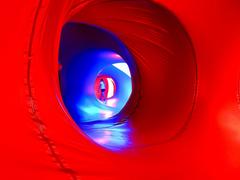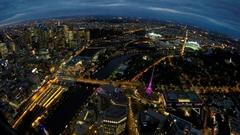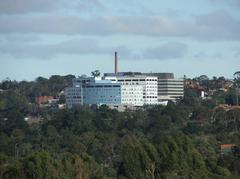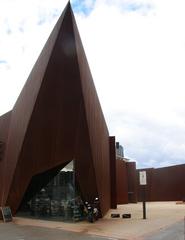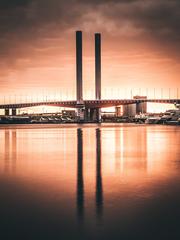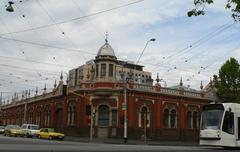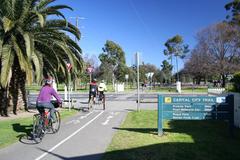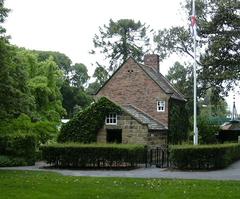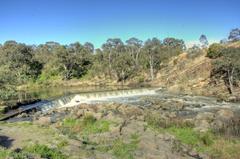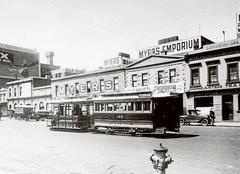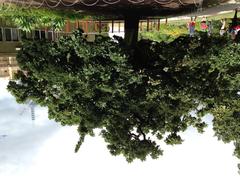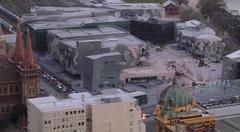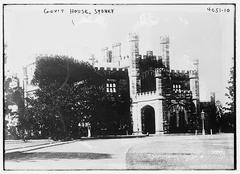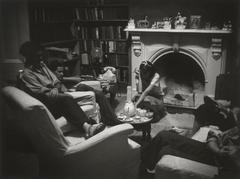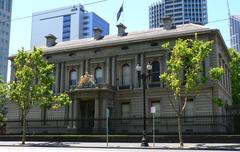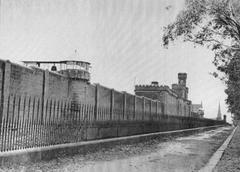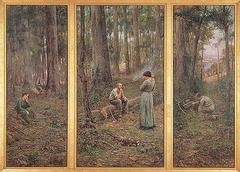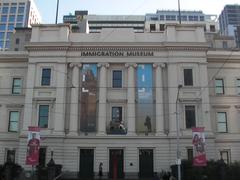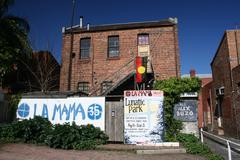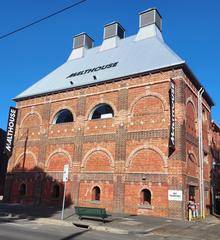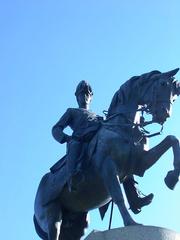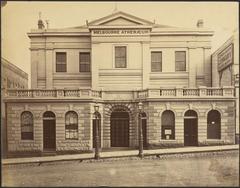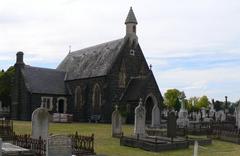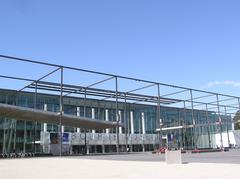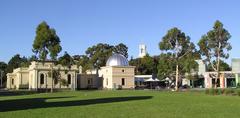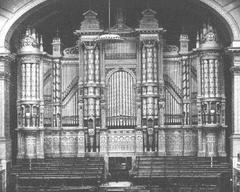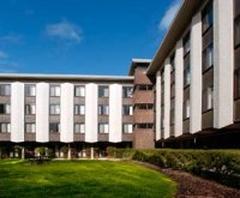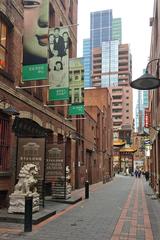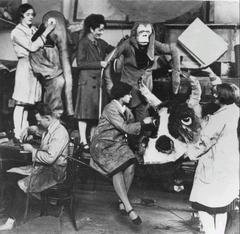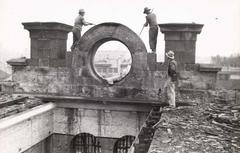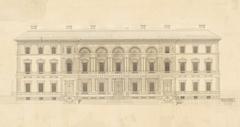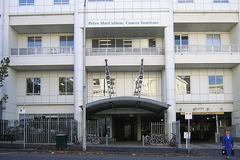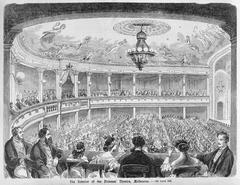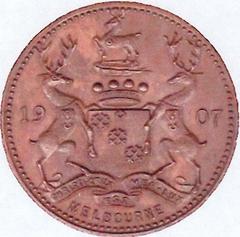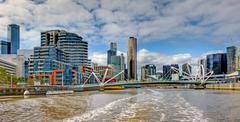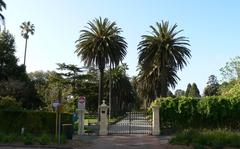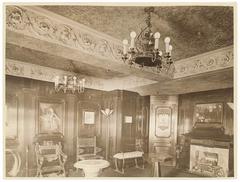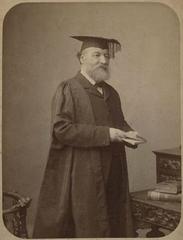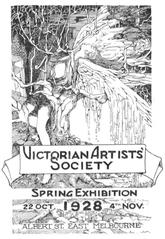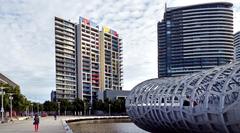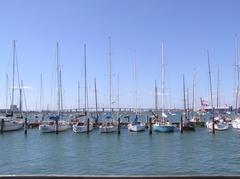Century Building Melbourne: Visiting Hours, Tickets & Historical Significance
Date: 14/06/2025
Introduction
The Century Building, located at 125 Swanston Street in Melbourne’s Central Business District, is a celebrated example of Streamline Moderne architecture and an enduring symbol of the city’s urban evolution. Erected between 1939 and 1940, the building’s sleek curves, horizontal lines, and iconic corner tower reflect the optimism and innovation of the interwar period. Beyond its striking aesthetics, the Century Building holds the distinction of being Melbourne’s first office block to feature air-conditioning, signifying a leap forward in workplace comfort and technological progress. Originally designed to include a cinema and ballroom, today the building is a vibrant mixed-use hub, seamlessly combining retail, creative offices, and cultural venues. Its ongoing relevance underscores Melbourne’s commitment to heritage preservation and adaptive urban development (Evendo; Heritage Council Victoria; Lonely Planet).
Visitors can admire the building’s terracotta façade, vertical piers, and ornate lantern-topped tower. Inside, original materials like sycamore veneer and stainless steel remain, especially in the lobby. Its central location on Swanston Street situates it near other architectural icons and bustling laneways, making it a practical starting point for exploring Melbourne’s rich urban landscape (AloneReaders; Timeout).
This guide covers the building’s history, architecture, visiting hours, accessibility, travel tips, photographic advice, and nearby attractions. It aims to provide insight and practical information for architecture aficionados, history enthusiasts, and casual visitors alike. For travel planning, it also highlights transport options and cultural events that cement the Century Building’s place in Melbourne’s vibrant city life (What’s On Melbourne; Gold Buyer Sharma).
Historical Context
Origins and Construction
The Century Building arose during a period of transformation in Melbourne’s urban fabric. Conceived in the late 1930s, it was designed to house commercial offices, retail spaces, and social venues, reflecting the city’s growth and modernization during the interwar years (Evendo). Its prominent location on Swanston Street ensured a central role in the city’s business and social life, bridging ornate Victorian influences with the streamlined design that defined emerging architectural trends (AloneReaders).
Heritage Status
The Century Building is heritage-listed, recognized for its architectural and cultural significance (Heritage Council Victoria). Its preservation is part of Melbourne’s broader initiative to safeguard historic landmarks, ensuring the building continues to connect present-day visitors with the city’s storied past.
Architectural Significance
Streamline Moderne Design
Designed by architect Marcus Barlow, the building is a paragon of the Streamline Moderne style—a late branch of Art Deco marked by aerodynamic curves, strong horizontal lines, and nautical elements. The off-white terracotta façade, vertical piers, and signature lantern tower define its exterior (Heritage Council Victoria; Gold Buyer Sharma). Inside, original features such as sycamore veneer, stainless steel, and decorative moldings evoke the luxury and craftsmanship of the era.
Integration with the Urban Landscape
The Century Building stands alongside other architectural masterpieces like the Manchester Unity Building and Flinders Street Station, exemplifying Melbourne’s blend of historic preservation and modern development (Timeout). Its presence on Swanston Street—a major artery of commerce and culture—embodies the city’s layered architectural identity (AloneReaders).
Visitor Information
Location and Accessibility
Address: 125 Swanston Street, Melbourne VIC 3000
The building is easily reached by tram (routes along Swanston Street), train (Flinders Street or Melbourne Central stations), and is within the city’s free tram zone. Accessible public entrances and elevators ensure visitors with mobility needs can access most areas, though some tenancies may have heritage-related limitations (What’s On Melbourne; City of Melbourne).
Visiting Hours & Entry
- Building Lobby & Public Areas: Open Monday to Friday, 9:00 AM – 5:00 PM (hours may vary for individual businesses and on public holidays).
- Retail Tenancies: Generally open 9:00 AM – 6:00 PM; some cafes and shops may operate later.
- Entry Fee: Free for public areas and retail outlets. Special events or exhibitions may require tickets.
- Guided Tours: While there are no permanent guided tours, various Melbourne walking tours include the Century Building on their itineraries (Lonely Planet).
Facilities
- Restrooms: Accessible toilets available within the building and nearby public facilities.
- Food & Drink: On-site and nearby cafes accommodate diverse dietary needs.
- Wi-Fi: Free public Wi-Fi is available throughout the CBD.
Accessibility
- Wheelchair access: Main entrances and lifts serve all commercial floors.
- Public transport: Multiple tram stops and two major train stations nearby.
- Accessible parking: Available in local car parks, though public transport is recommended due to limited parking (City of Melbourne).
Activities and Photographic Tips
- Architectural Details: Best photographed in early morning or late afternoon light. Focus on the façade, lantern tower, and lobby interiors.
- Combine Visits: Pair with stops at the Manchester Unity Building, Capitol Theatre, and nearby arcades for a self-guided heritage walk.
- Cultural Events: During city festivals, exhibitions, and pop-ups, the Century Building often features arts and cultural programming (Secret Melbourne).
Nearby Attractions
- Melbourne Town Hall
- Manchester Unity Building
- Block Arcade
- Royal Arcade
- Collins Street
- West Space
- Nicholas Building
- Anna Schwartz Gallery
- Hosier Lane
- Queen Victoria Market
- NGV International
- Melbourne Cricket Ground (MCG)
- Shrine of Remembrance
- Royal Botanic Gardens
- St Kilda Foreshore
Frequently Asked Questions (FAQ)
What are the Century Building’s visiting hours?
Monday–Friday, 9:00 AM–5:00 PM for public areas. Individual business and event hours may vary.
Is there an entry fee?
No; public areas and retail outlets are free to enter. Special events may require tickets.
Are guided tours available?
No permanent tours, but building is featured in various Melbourne architecture walks.
Is the building wheelchair accessible?
Yes; main entrance and elevators are accessible, but some tenancies may have limitations.
Can I take photographs?
Yes, in public and exterior areas. For interior photography, seek permission from tenants or event organizers.
Cultural and Contemporary Context
The Century Building stands as a testament to Melbourne’s embrace of both heritage and progress. Its adaptive reuse, participation in local events, and role in the creative economy reinforce its place in the city’s contemporary narrative (Planning Victoria). Nearby, the city’s laneways, arcades, and cultural venues host year-round festivals, exhibitions, and markets, ensuring a vibrant visitor experience. The building’s position on the traditional lands of the Wurundjeri people of the Kulin Nation is acknowledged by the City of Melbourne, and visitors are encouraged to learn about and respect this enduring heritage (Heritage Council Victoria; City of Melbourne).
Practical Tips
- Use public transport for convenience.
- Visit during business hours for interior access.
- Combine your visit with neighboring heritage sites and laneways.
- Check What’s On Melbourne for current events.
- For accessibility needs, see Accessing Melbourne.
- For architectural photography, visit in the early morning or late afternoon.
Visuals
Alt text: Century Building façade with bold white vertical lines and blue-tinted glass, an iconic Melbourne historical site.
Alt text: Interior lobby of the Century Building featuring historic materials and modern refurbishments.
Summary
The Century Building is a must-visit for those interested in architecture, history, and Melbourne’s dynamic urban culture. Its Streamline Moderne design, historical importance, and central location make it an accessible and enriching stop whether you are exploring on your own or as part of a guided walk. Take time to appreciate its details, attend an event, or simply enjoy its place within the city’s vibrant precinct. To stay updated on tours, exhibitions, and accessibility resources, download the Audiala app and consult official city guides.
References
- Evendo
- AloneReaders
- Timeout
- Heritage Council Victoria
- Gold Buyer Sharma
- Lonely Planet
- What’s On Melbourne
- City of Melbourne
- Secret Melbourne
- Planning Victoria
